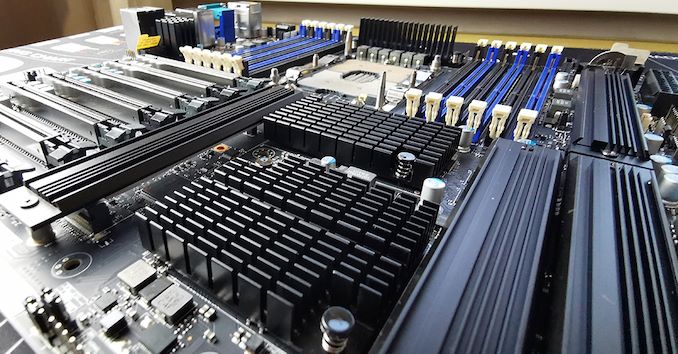The Supermicro X11SPA-T Review: An Impressive Cascade Lake Workstation Motherboard
by Gavin Bonshor on January 24, 2020 9:00 AM ESTSupermicro X11SPA-T Conclusion
The Supermicro X11SPA-T is an impressive E-ATX form factor motherboard for Intel's Xeon W workstation-based CPUs. It is designed for professional use including workstations and servers. Although not a server board, there is a typical array of server functionality provided.
Visually the Supermicro X11SPA-T has a unified aesthetic through a black PCB and is easy on the eye, and most use cases for this model should be within a high-end chassis with proper cooling or even a server blade which supports E-ATX models. The X11SPA-T offers users plenty of different configurations with its seven full-length PCIe 3.0 slots, with four x16, and three x8 slots. One benefit of so many full-length slots is graphics card support with one option available is to use it as a powerful virtual machine with multiple graphics cards.
Another benefit of the number of full-length PCIe 3.0 slots is to use the bandwidth of the slots for dedicated RAID controllers and create a large bank of storage drives in either RAID 0, 1, 5, or 10 arrays. Add in support for up to 3 TB of ECC DDR4-2933 memory and depending on processor support, or Intel's DCPMM modules with the higher-end Xeon SKU's including the Gold and Platinum series, and the possibilities are endless. With twelve memory slots and support for both LRDIMM and RDIMM DDR4 memory in hex-channel mode, the Supermicro X11SPA-T provides a solid foundation for taking advantage of what C621 has to offer.
With an ASPEED 2500 BMC controller and assisted by a Realtek RTL8211E PHY on the rear panel, remote access to our test machine worked flawlessly. This includes with Supermicro's SD5 software, and through the IP accessed control panel which included Java support for real-time monitoring. Other features include an Aquantia AQC107 10 G Ethernet controller, with a second port which is powered by an Intel I210-AT Gigabit controller. The rear panel also includes two USB 3.1 G2 ports, with a single Type-A, and a single Type-C. A Realtek ALC888 takes care of the audio and even includes an S/PDIF optical output.
The Supermicro X11SPA-T has a current price tag of $620 at Amazon, which is a very fair representation given the quality of the controller set and the features on offer. It's a drop in the ocean in comparison to the consumer models such as the ROG Dominus Extreme which has an MSRP of $1800, and as expected, has a much more consumer-focused target market with many bells and whistles which aren't required for workstation use. For its price point, it puts it in line with dual-socket LGA3647 options, including the WS C621E Sage for $616.
Supermicro is one of the market leaders in workstation offerings and it's easy to see why through the X11SPA-T single-socket LGA3647 motherboard. It's on the pricey side with its current retail price of $620, and it could be improved upon, especially in the software and firmware, but for features it is quite solid. The biggest compliments to the X11SPA-T is that it works in every department it's designed for, it performs well, and it has the added advantage of looking good.











31 Comments
View All Comments
Pneumothorax - Friday, January 24, 2020 - link
I'm sure the profit margin on these is quite a bit less then ridiculously overpriced Z390 & X570 boards named after some deity...Operandi - Friday, January 24, 2020 - link
True for some of them for sure but a lot of the consumer boards that are aimed at the high-end overclocking are the real deal in terms of engineering. Very powerful and efficient VRMs are not cheap and a lot more overbuilt than on something like in this board so the margins are probably not as crazy high as you think (at least in the middle of the Z390 X570 market).airdrifting - Sunday, January 26, 2020 - link
What overclocking are you talking about? Overclocking a 9900K from 4.7GHz stock all core turbo to 5.0GHz and look at 95C loaded temperature, or overclocking Ryzen 0.1GHz past the precision boost? You kids don't know anything about overclocking nowadays.Ironchef3500 - Monday, January 27, 2020 - link
+1brucethemoose - Monday, January 27, 2020 - link
+1There is *a little* headroom in HEDT CPUs, for now...
web2dot0 - Tuesday, February 11, 2020 - link
Still remember those Celeron 300A days OC to 450MhzThe glory days of Overclocking ...
Operandi - Friday, January 24, 2020 - link
I will say the marketing sucks though. I don't give a fuck about an Aorus regardless of how extreme it may be and I really don't want to join a republic, thanks for asking though.GreenReaper - Sunday, January 26, 2020 - link
They're not exactly *asking* - the red-cloaked tide of Gamers have annexed several nearby states. For a while it looked like they'd take the Ministry of Sound, but fortunately Realtek pushed them back.Operandi - Friday, January 24, 2020 - link
Also, these comments are in reverse order cause there isn't a edit button. Oh well.....rahvin - Friday, January 24, 2020 - link
The 570 boards are expensive because they are the first PCIE4 motherboards. That and they needed a 12 layer board to get the pcie trace lengths within the spec limits. As the OEM's get more experience with 4.0 they'll drop in price but the first boards are always going be $$$ because of the additional engineering. You might not remember but the first 3.0 boards were more expensive too.